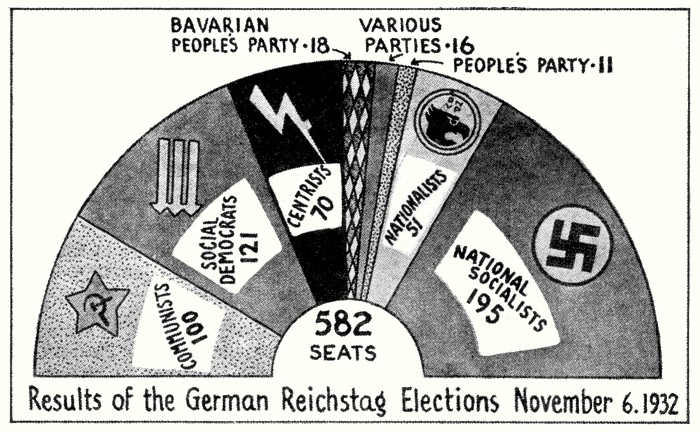Hitler's Shattered Dream, 1932
a discussion of —
"Hitler's Shattered Dream of Dictatorship"
The Literary Digest, 17 December 1932
Whistling into the storm
In The Literary Digest's department of Foreign Comment for 17 December 1932, the magazine summarized and discussed reports of the recent elections in Germany on 6 November 1932. The magazine's article was titled, "Hitler's Shattered Dream of Dictatorship". Their article looked at the electoral numbers and trends, and drew what seemed the reasonable conclusion that we see in their title:
Adolf Hitler's dream of becoming dictator of Germany by legal means is said to have been "dissipated forever" as the results of the Reichstag election on November 7.
For the first time since the Brown Shirts, led by their fiery and eloquent chief, leapt into world-wide prominence two years ago, The National Socialists (Fascist) party suffered a setback at the polls in the election of the seventh Reichstag of the German Republic.
The Nazis. as they are familiarly known, polled 2,000,000 votes less than their high-water mark in the parliamentary election of July 31, and they will have 195 deputies in the new Reichstag as compared to the record number of 230 they registered in the old.
The Literary Digest furnishes the total deputies for fifteen parties and the popular vote for nine of these, although the precise numbers aren't important — and in fact the magazine text has gotten the date wrong. The Nazis had the biggest decline of two million votes and 35 seats, followed by the Socialists; while the Nationalists and Communists gained seats. The Nazi Party (NSDAP / National Socialists) retained its plurality, although diminished. Hermann Goering had become President of the Reichstag on 30 August 1932 after the previous election and subsequent negotiations, and retained this office for the Nazi Party.
The news magazine quotes extensively from John Elliott, Berlin correspondent to the New York Herald Tribune, of which I find this particularly revealing:
Of these 582 Deputies, 416 belong to "Socialist" parties of one shade or another, 195 to the National Socialists, 121 to the Social Democrats, and 100 to the Communists.
The fourth largest party, the Catholic Center party, which is represented by sixty-nine Deputies, also is influenced largely by its trades-union section.
Elliott characterizes Alfred Hugenberg's Nationalist party as the only bourgeois political party that "has any considerable strength". This is the party of the monarchists in Germany.
Most of the larger political parties were in principle if not always tactically hostile to the Weimar Republic as constituted.
The Literary Digest's English-relabeled German chart of Reichstag representation after the November 1932 election has haunted me for years:
- Practical: No party holds close to a stable parliamentary majority.
- Practical: No stable alliance of parties is likely to be formed to maintain such a majority.
- Principled: No party presents a clear value to vote for.
This political mess after frequent elections in the late Weimar Republic forms a heavy weight in the balance against a system allowing a multiplicity of minority parties, all essentially at ideological loggerheads. Too often such a system produces a coalition administration in which the jointly ruling parties detest each other.
With benefit of hindsight, we may look beyond the optimism of The Literary Digest, and of the world, at the end of 1932. The squabbling multiparty interlude was highly unstable and resulted in the single-party totalitarianism of the Nazi state, a disaster for Germany and the world.
Less than three months after this last Weimar Republic election, on 30 January 1933 the President of Germany, Paul von Hindenburg, appointed Adolf Hitler — he was not elected — Chancellor of Germany.
After 14 July 1934 the Nazi Party was the only legal political party.
On 12 November 1934 the first election under the Third Reich thus readily provided the decisive pro-Nazi results that Hitler wished, 92 percent of the popular vote and an essentially all-Nazi slate in the Reichstag.
© 2011 Robert Wilfred Franson
Oops — Hitler!
A Surprise in Context
Nazi-Communist Partnership
Elective Affinities, Offensive Alliances
The Reichstag Fire
Legend and Truth
by Fritz Tobias
Germany at Troynovant
Prussia, Bavaria, Austria,
Imperial Germany, Third Reich
Utopia at Troynovant
utopia in power, or dystopia
chart, bottom:
Reichstag election
6 November 1932,
seats by party.
The Literary Digest
contrast modern charts of
German elections;
click / move cursor
to show provincial / party detail.
Atlas zur Bundestagswahl 2013
Wahlatlas
Atlas zur Europawahl 2019
in Deutschland am 26. Mai
Wahlatlas
2024 European Election in Germany
Europawahl 2024
9 June 2024
Wikipedia

| Troynovant, or Renewing Troy: | New | Contents | |||
| recurrent inspiration | Recent Updates | |||
|
www.Troynovant.com |
||||
|
Essays:
A-B
C-F
G-L
M-R
S-Z
|
||||
| Personae | Strata | Topography | |
|
|||